

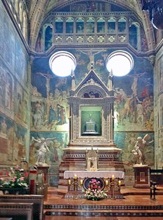
The Cappella del Corporale was built as an extension to the left transept of the Duomo in 1350-6 to house the relic of the Sacro Corporale (the linen altar cloth that had been stained by the blood of Christ in 1264, during the Miracle of Bolsena).
The new sacristy, which is reached via the door in the right wall, was also built at this time.
Sacro Corporale
Reliquary of the Sacro Corporale (1337-8)
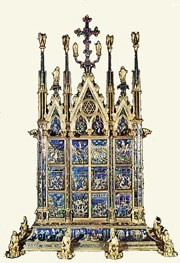
The double-sided reliquary replicates the arrangement of the facade of the Duomo. The eight enamels in the upper and middle registers of the shutters on the front constitute the earliest surviving narrative depiction of the Miracle of Bolsena and formed the basis for future representations, including the frescoes of this subject in this chapel (see below). The other four enamels on the front and the twelve enamels on the back depict scenes from the Passion, and those around the base depict scenes from the early life of Christ.
Tabernacle (1358-63)
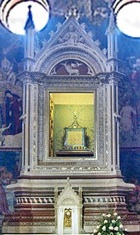
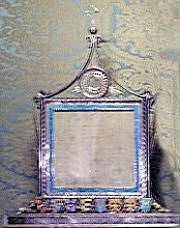
This tabernacle on the altar was commissioned to house the Sacro Corporale and its original reliquary. A certain Nicolò da Siena was commissioned to design it in 1358, and it is usually assumed that Andrea Orcagna (who was capomaestro at this time) directed the project. Fittings were commissioned in 1363, presumably to hold the finished tabernacle in place. A set of keys was commissioned for the tabernacle in 1366, together with a set of stairs, presumably to facilitate access to it.
The tabernacle has a relief of the Agnus Dei in the lunette, with a relief of Christ the Redeemer in the gable above. The gilded doors have images of the Virgin, St John the Baptist and angels.
The tabernacle still houses the Sacro Corporale, although now in the more portable reliquary that is still used in the annual procession.
Narrative of the Miracle of Bolsena (1601-2)
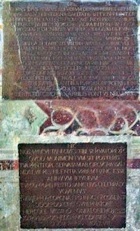
Art in the Chapel
Frescoes (1357-64)
These frescoes were commissioned in 1356 from Giovanni di Buccio di Leonardello and Ugolino di Prete Ilario. Giovanni di Buccio soon left the team to concentrate on the mosaics of the facade. Ugolino di Prete Ilario continued the work with the assistance of a number of other local artists, including Petrucciolo di Marco, Domenico di Meo, Antonio di Andreuccio and Pietro di Puccio. He signed one of the frescoes on the back wall as Ugolino, painter of Orvieto, and dated it very precisely to 8th June 1364, which was presumably the date of completion of the entire programme of decoration. Many of the scenes have Latin explanatory inscriptions (1362) devised by “Ser Checco di Pietro”.
Unfortunately, the frescoes were poorly restored in 1857-60 following the visit to Orvieto of Pope Pius IX. Some of the original sinopie were discovered during the restoration of 1975-8. They were detached at that time and are now in the Museo dell' Opera del Duomo.
Scenes from the Passion
The frescoes on the back wall depict:
-
✴the Crucifixion;
-
✴the Last Supper; and
-
✴the Resurrection.
Miracle of Bolsena
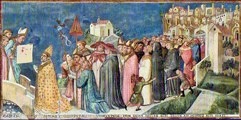
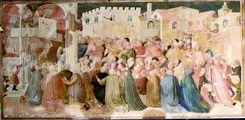
Urban IV greats the Bishop of Orvieto Urban IV shows the Sacro Corporale to the people
at the bridge over the Rio Chiaro as he returns of Orvieto from the loggia of Palazzo Papali
from Bolsena with the Sacra Corporale
The eight frescoes on the right wall of the altar bay depict scenes from the events surrounding the miracle of Bolsena. Some of them provide interesting views of Orvieto in the 14th century. For example:
-
✴the original church of San Lorenzo delle Vigne can be seen to the right of the bridge over the Rio Chiaro in the fresco illustrated on the left above
-
✴Palazzo Soliano and the tower house that later provided the site for Palazzo Buzi can be seen to the right of the loggia of Palazzo Vescovile in fresco illustrated on the right.
Eucharistic scenes
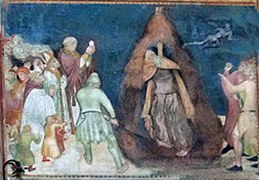

A priest drives the devil from a condemned A Jewish man burns his son,
heretic by elevating the consecrated Host who has eaten the consecrated Host.
[Where in the entrance bay ??] In a later scene, the Virgin intervenes and
the boy is safely removed from the flames
(Left wall of the altar bay)
Many of the other frescoes in the chapel provide graphic details of the power of the consecrated Host and the unhappy fate of people who fail to venerated it.
Other Art in the Chapel
Madonna dei Raccomandati (1339)
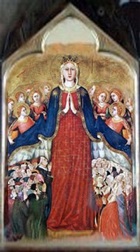
Monument to Orsino and Rodolfo da Marsciano (1522-45)
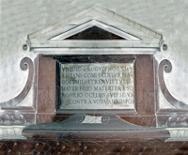
Michele Sanmicheli was commissioned to execute this monument on the right wall in 1522, but the work was still in the design phase in 1524. Further delay arose in 1527, when the money that had been bequeathed to pay for the monument was "borrowed" as a contribution to the fortification of the city during the tense period before the sack of Rome. Simone Mosca completed it in 1544-5.
[Who were the deceased ???]
Monument to Bishop Sebastiano Vanzi (1571)
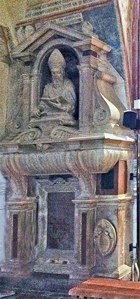
Bishop Sebastiano Vanzi was an eminent jurist who distinguished himself at the Council of Trent in 1562-3. His will of 1567 contained a substantial bequest to the Opera del Duomo. He intended that this should finance, among other things, a bronze tomb in front of the high altar, which would be used for his own burial and for those of his successors. Work on the design was started, but the project came to a halt after Bishop Vanzi retired in 1570. He died a year later.
Bishop Vanzi had also suggested that part of his bequest should be used each year for a temporary model of the Church of the Holy Sepulchre, which would be erected in the Cappella del Corporale to house the reserved Host during Easter week. In the event, a tomb in local stone (which was much cheaper than bronze) was erected for Bishop Vanzi in this chapel. His marble bust above the sarcophagus was positioned so that he would be seen to participate in the annual services at the temporary sepulchre.
Return to the main page on the Duomo.
Continue to: Cappella Nuova; Crypt.
Return to: Exterior; Facade; Interior; 16th Century Remodelling.

